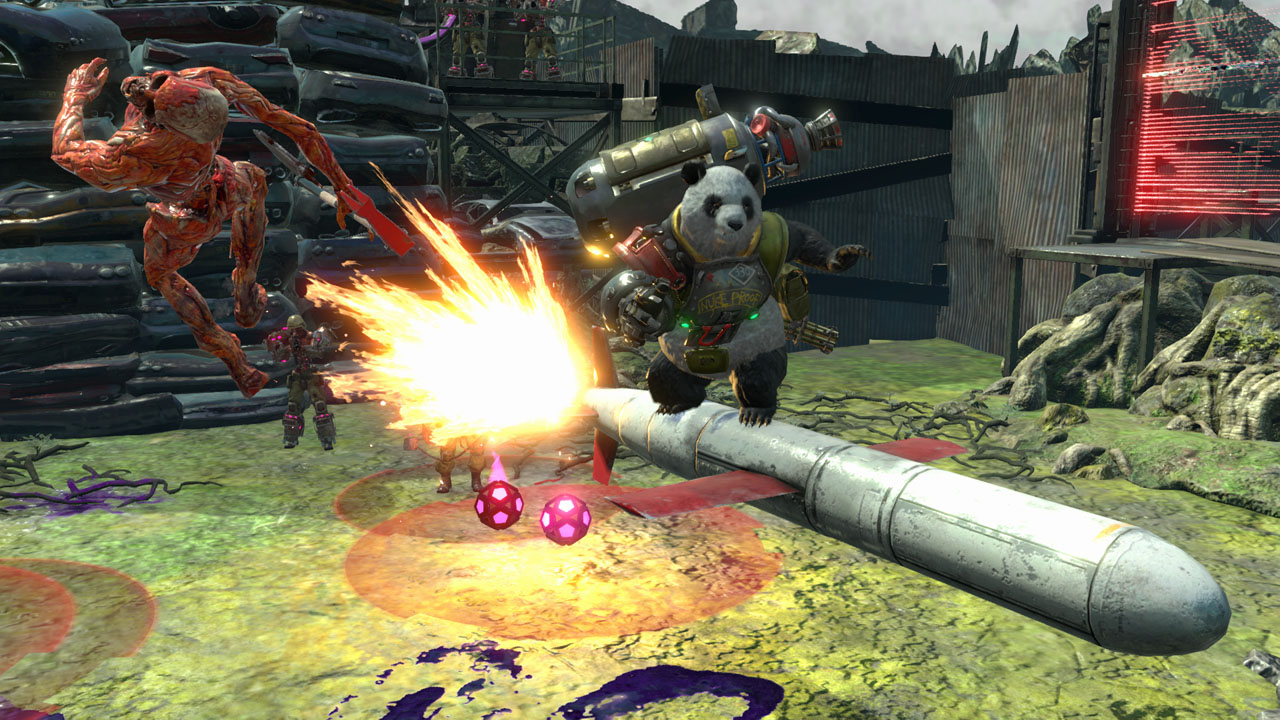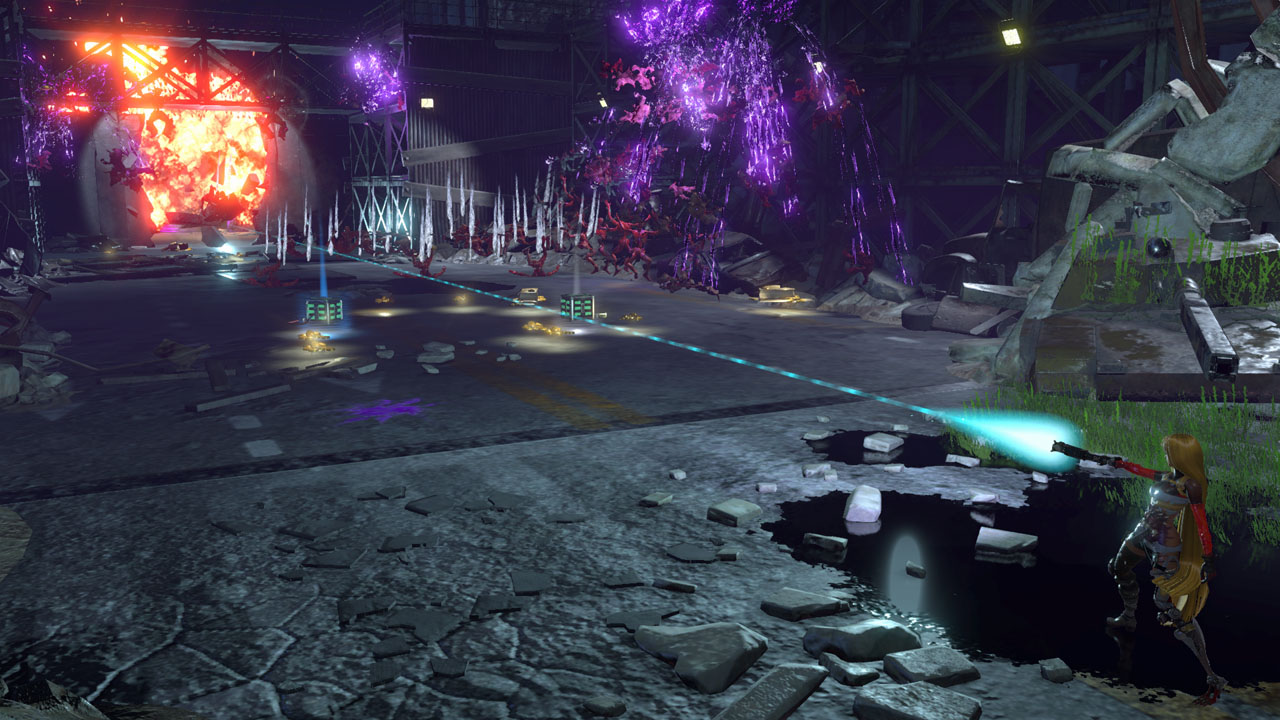[Review] Contra: Rogue Corps
System: Switch
Release date: September 24, 2019
Developer: Konami
Publisher: Konami
Contra: Rogue Corps is a fever dream. It’s an unexpected revival of a long-dormant franchise in a new genre, one in which an cybernetic panda can tear through an alien horde while a shirtless soldier declares that “You know I had to do it to ’em” as he rides a rocket into said crowd of fiends. On top of this absurdity, it is also one of the blandest, ugliest, and most disappointing games I’ve yet had the pleasure of reviewing. But how did Rogue Corps go so wrong? Let’s review aggressively and find out.
It all begins a few years after the events of Contra III: The Alien Wars, in which the earth is immediately hit with another onslaught of alien attackers. This time around, the demons have created an entire “Damned City” of their own, which is eloquently described as looking “like it was shot out of Lucifer’s asshole.” Coincidentally, this also occurs at the same time that the President of the World (because Earth is apparently a one-state planet at this point) gets assassinated. This leaves it up to you and your band of outlandish companions – including a weaponized panda, a woman whose pelvis is perpetually consumed by an alien, and a gentlemanly British extraterrestrial – to save humanity from caving in on itself in the wake of this crisis.
I never had high expectations for Contra: Rogue Corps’ story – it is a Contra game, after all – but even then, it completely misses the mark. Previous Contra games had a strange sort of innocence about them, telling simple stories about alien invasions complete with horrible yet endearing localization (“Let’s attack aggressively” is still one of the best lines in classic games, bar none). On the other hand, Rogue Corps feels incredibly self-conscious about its tone – it’s intentionally trying to be as weird as possible, which leaves it coming off as awkwardly forced. The anthropomorphic panda or gentlemanly alien have no reason to be in the game other than some arbitrary attempt at humor.
The dialogue doesn’t help with this either, considering that it’s written with the eloquence of a twelve-year old who just learned the F-bomb. It’s interspersed with references to old memes – again, you know that the game’s writer had to do it to ’em – which might come off as endearing for some, but for most it will likely be cringeworthy at best. It doesn’t help that it’s riddled with basic typos that I’d have hoped most professional writers would have managed to prevent at this point, but perhaps Konami wanted to match its middle-school profanity with middle-school grammar.
The story may not be the best, but as with any action game, it’s the gameplay that really matters. Of course, Contra: Rogue Corps falls flat in this regard as well. To put it simply, it seems to have no idea how to make a proper Contra game. It ditches the series’ signature side-scrolling combat for an isometric twin-stick shooter approach. This change isn’t bad in its own right – after all, every legacy series needs to have a bit of innovation every now and then. However, the twin-stick gameplay simply doesn’t provide the same extravagant action that Contra is known for. Rogue Corps’ top-down levels are uniformly bland, featuring none of the spectacle that made classic Contra so memorable. Stages consist of the same general mix of featureless corridors stuffed with waves of cookie-cutter enemies punctuated with the occasional boss, whose only difference from regular enemies is that it’s an elephantine bullet sponge. Even if a level introduces a unique gimmick or enemy, it’s not long before it gets repeated incessantly – you’ll see the exact same level maps pop up again and again throughout the campaign. It’s not uncommon to see level layout repeated even within the next two missions. Most levels give you nothing to do except lay your finger on the trigger and never let go.
But the thing is, you can’t hold down the trigger, due to one truly bizarre design decision: the inclusion of a cool down meter. You can barely fire for more than a few seconds straight before your weapon jams, either forcing you to switch to a secondary weapon or leaving you defenseless entirely. It means that you can’t charge into the enemy crowds with your guns blazing and your adrenaline pumping as in classics Contras; instead, you’re forced to shoot for a little bit, wait a few seconds, shoot some more, and so on, until everything finally falls dead. It feels contradictory towards what makes a good action game, and more specifically, it doesn’t even feel like a true Contra.
At the very least, there is a robust customization system, allowing you to modify your weapons and switch out body part in an attempt to increase your stats. But it’s almost overwhelmingly complex, and it feels strange to have such depth in a Contra game. I don’t know about you, but I play Contra for dumb, mindless violence; if I wanted to intricately tweak every aspect of my characters, I’d be playing Dragon Quest. Perhaps the game as a whole isn’t offensively bad – if you want nothing more than a top-down shooter that functions at little more than the bare minimum, then this should do you just fine. For anyone wanting a game that continues the proud legacy of the Contra series, however, Rogue Corps will do nothing but crush your militant dreams.
It doesn’t help that it’s a truly hideous game on Switch. In handheld mode, the entire world looks as if it’s been dunked in Vaseline and then put through a woodchipper thanks to the blurry textures and endless rough edges. The visuals are so dull that it can sometimes be impossible to understand what’s going on when playing portably. Things aren’t much better when docked, either. This mode features all the same visual blemishes of handheld mode, but now blown up on a bigger screen. The resolution is slightly improved at this point – at some points, it might even be HD – but the textures remain muddy and every model is still rife with rough edges. The performance might be solid on Switch, but when the game is so impressively ugly, it’s only a thin layer of icing on a moldy, pixelated cake. Rogue Corps would look out of date back in 2006; it certainly doesn’t look any better in 2019.
If for some sadistic reason you’d like to drag others into this mess with you, then there’s a variety of multiplayer modes on offer. Local couch co-op is available, but strangely enough, this content is off limits until reaching a certain point in the story, and even when it is unlocked, it only allows you to play through flat, randomly generated “exploration” levels, which impressively manage to be duller than the main single-player stages. Beyond that, there’s also an ambitious, eight-player multiplayer mode, one that I’ve hardly had the chance to try since apparently I’m the only person on this godforsaken earth unfortunate enough to have to try and play this game online. If I couldn’t find anyone to play with during the game’s first week on the market, when its player base should theoretically be at its highest, then I doubt that there will be many fellow players in the future. While it is disappointing that I’ve barely been able to give this content a shot, I highly doubt that it would excuse the sadistic gameplay, the repetitious structure, and its unforgivably atrocious graphics.
The Verdict

Contra: Rogue Corps tries to revive its series but only ends up pushing it further into its grave. It should have been the franchise’s triumphant return after years of languishing in Konami’s prison cellar of unused classic IP, but instead, it’s a shambling relic of the bombast that made Contra so special to begin with. It has the writing of a middle school dropout, the graphics of a low-budget PS2 game, and a repetitively bland gameplay style that can’t even decide on whether it wants to be a Contra game or not. It’s the rare case of a game that can’t be redeemed by having a playable panda bear, and if that doesn’t tell you how oppressively underwhelming the experience is, then I don’t know what to tell you.
Contra: Rogue Corps review copy provided by Konami for the purposes of this review.



